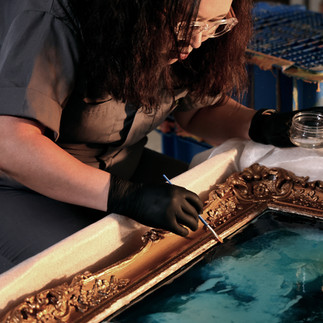옛 대나무에 새순이 돋아나고 새 꽃은 옛 가지에서 피어난다.(구죽생신순 신화장구지/舊竹生新荀 新花長舊枝)” 신미경의 작업은 과거와 미래를 잇는 ‘현재성’을 완성이 아닌 참여적 행위를 통해 드러낸다. 말 그대로 ‘새로 피어나는 꽃(新花)’은 동시대 사람들의 참여, 장구지(長舊枝)는 문화유산의 재해석을 통해 얹어진 ‘미래로 연결된 작품’을 말한다. 작가의 기존 비평들은 대부분 ‘폐허 속에서 피어난 꽃-시간성의 가시화’를 통해 작가의 현재적 행보에만 주목해 왔다. 신미경 작가는 비누를 매개체로 삼아 과거와 현재를 가로지른 ‘되어지는 속성’에 주목한다. 작품이 “사라지고도 존재하기” 위해서는 자연 풍화(야외조각)와 인위적 행위(화장실 프로젝트)를 종합한 ‘되어지는 감각’ 을 더해야 하며, 작가의 손을 떠난 작품들은 계속해서 동시대적 언어를 덧입어가야 하기 때문이다. 제2회 하인두예술상 수상자 전시에서는 한국성을 담보한 국제성으로 문명의 가치를 번역해 온 작가의 미공개작과 신작들이 펼쳐진다. 비누는 쉬이 부서지며 마모되어 종국에는 자연으로 돌아가는 ‘순환의 속성’을 지닌다. 작가는 비누를 소재로 경배의 대상으로 사용된 조각상 혹은 불상 등의 외연을 ‘사라지고 존재하는 레이어’로 설명한다. 작가의 조각은 시대의 원본이자 미래를 향해 작동하는 ‘예술 인류학적 언어’로 표상된다. 이는 오래된 문명을 고법(古法)에 근거한 정형화된 인식으로 바라보는 시선에 돌을 던지는 철학 행위다. 작가는 우리가 당연하다고 생각해 온 ‘문명의 가치’를 재료와 개념 모두에서 번역해 냄으로써, 미술의 절대성이 아닌 상대적 가치를 질문하게 한다.
일상적 재료와 개념적 속성 사이, 어리석음을 향한 질문들
신미경의 작품에는 노장사상(老莊思想)의 한국적 재해석이 자리한다. 개인의 내적 성찰과 조화로운 삶을 중시한 ‘선인(先人)들의 사유’를 동시대 미술 언어로 옮겨낸 것이다. 노장사상의 특성은 자연과의 조화를 받아들이는 내적 성찰을 통해, 사회적 관습을 초월하여 일상생활의 깨달음을 유도하는 것이다. 신미경의 비누는 거품 같은 일상생활의 욕망을 보여주는 ‘원형 예술’ 이다. 작품의 ‘되어진다는’ 속성은 형상이 부제가 되고 번역 행위가 본질이 되는 ‘스스로 그러한, 자연(自然)’에서 추출한 개념인 것이다. 예술 의지를 ‘흐르는 시간(流時)’에 의탁했을 때, 작품은 현재를 매개로 한 ‘생장태’로써 기능한다. 작가는 “인간은 왜 종종 어리석음에 빠지는가?”라는 판단 행위에 주목함으로써, 자율적 합리성과 효율적 유연성에 가치를 부여한다. 어찌 보면 번역된 비누 조각은 선험적 가치로 모든 것을 판단해버리는 현재적 어리석음에 관한 고찰이라고 할 수 있다. 우리가 너무나 당연하게 생각하는 방식들에 낯선 속성을 부여함으로써, 모사(mimesis; 대상의 표피성)라는 편견에서 벗어난 유동적 인간 행위에 주목하고자 한 것이다. 유약하고 연약한 비누의 물성이 ‘문명의 생존체=유물’과 만났을 때, 우리의 사유는 더욱 물컹해지고 기존 대상이 지닌 원본성의 가치는 빛날 수밖에 없다.
신미경의 한국성, 다시 타오르는 ‘혼불’의 계승
풍화되고 사라지는 비누의 물성을 권위주의의 해체로 본 신미경은 아시아 여성작가라는 한계를 뛰어넘어 부단히 자기 개성화의 길을 걸어왔다. 동서 문화의 맥락을 새로운 담론과 방향성으로 번역해 온 예술 인류학자 같은 여정은 향후 동시대 미술의 가능성과 새로운 대안을 제시할 것으로 기대된다. 작가는 한국과 영국을 오가며 왕성한 작품 활동을 펼쳐오고 있다. 세계적인 유수의 기관에 작품이 소장되는 국제적인 명성은 ‘자기 한계를 받아들이고 서구적 외형 안에 숨은 보편적 가치를 한국적 깊이’로 해석한 데 따른 것이다. 작품의 방향 역시 독자적인 화풍을 구축하고 한국적인 추상미술을 선도하며 한국 근현대미술사에 유의미한 영향을 끼친 하인두(1930~1989) 의 예술 정신과 닮았다. 한창 작업에 매진할 59세란 나이에 세상을 떠난 하인두 작가의 창작열은 예술로 연결된 시간성의 가시화를 통해 우리 앞에 자리한다. 신미경이 유물의 경계를 과거가 아닌 연결되는 속성으로 보듯이, 하인두의 <혼불>은 사회로부터 개인이 자유로울 수 없는 현실에서도, 다시 타오르는 예술 정신을 일깨운다. 남아있는 것과 사라진 것의 경계, 그 너머의 상상 속에서 작품들은 새로운 번역을 기다리며 ‘시대의 참여(participation of the times)’를 작품으로 이어간다. 전시에서 발표한 갈색조의 도자기들은 덤덤히 색을 내려놓은 채 우리를 맞는다. 헤리티지는 과거에 지나갔지만, 이를 번역한 작업들은 원본의 가치를 머금고 매 순간 변화하는 ‘지금-여기의 한국성’으로 계속해서 진화한다. 금강경야부송(金剛經冶父頌)의 ‘신화장구지(新花長舊枝)’ 를 결과가 아닌 ‘시간의 가능성’으로 재해석한 신미경의 작품들은 과거로부터 대물림되는 문화유산의 새로움에 방점을 찍는다. 수백 년 시간을 잇는 예술의 직관을 ‘사라지고도 존재하는-순환의 시각’으로 재해석한 것이다.
맥락을 품은 사의(寫意)의 미학화, 되어지는 아이콘
비누의 향기가 후각을 자극하는 순간, 우리는 시각과 촉각이 동시에 반응하는 놀라운 경험을 하게 된다. 고정된 가치를 뒤흔드는 작업들은 ‘시·공간적 요소의 종합’에서도 발견된다. 작가의 부모님께서 모았던 다양한 골동품들은 ‘고고학에서 말하는 연대’가 무엇인지를 알려주는 계기가 되었다. ‘조선일제 강점-근대’ 등 흘러가는 시간에 따라 만들어진 속성들은 유물이 고정된 가치가 아닌 우리 앞에 재해석돼 존재한다는 사실을 알려준다. 말 그대로 작가의 작업은 형태는 동일하지만 역사를 덧입는 새로운 작업들이라는 뜻이다. 이 경험은 유학 시절 영국 박물관에서 본 특정연대로서의 유물로까지 이어진다. 하나의 사물이 맥락을 바꿨을 때, 아이콘은 해체-재구성을 통해 ‘맥락까지 품은 새로운 맛’을 얹게 된다. 이는 물상 세계에 대한 재현보다는 자신의 정신세계와 결합해 해석한 동양적 “사의(寫意) 개념”과도 연결된다. 서양화에서처럼 선·색·구도가 어떤 유파에 속하느냐 보다, 작가의 세계관은 아이콘(icon)과 맥락(context)이라는 요소의 조화에 따라 이루어지기 때문이다. 신미경의 아이콘이란 화면 속에 나타나는 동·서 문명의 여러 헤리티지를, 맥락이란 이들 아이콘이 담고 있는 의미와 메시지의 시간적 메시지를 의미한다. 예를 들자면 필라델피아 미술관에서 열렸던 ‘The Shape of Time: Korean Art after 1989’전(展)에 출품한 외형 조각이 (2024)이라는 작가적 아이콘이라면, 전시 기간 외부의 풍화작용은 하나의 맥락이 된 셈이다. 이러한 맥락을 작가는 ‘번역’이고 표현한다. 언어적인 것뿐만이 아닌, 국가-문화-문명의 경계를 가로지르는 변화의 코드라는 것이다.
‘화장실 프로젝트’의 경우 조각이나 불상 등을 재현해 공공장소인 화장실에 설치·이용하게 한 후, 작품이 마모되는 일정 기간을 거쳐 다시 수거된다. 이는 외부 조각도 마찬가지다. 어느 정도의 풍화작용을 거치면 작업은 화이트 큐브로 들어와 ‘맥락을 머금은 작품’으로 전시된다. 각각의 비누 조각들은 시간이 지남에 따라 각기 다른 모습으로 닳아진 흔적을 끌어안게 된 것이다. 미국 최초의 뮤지엄인 필라델리피아가 100년 만에 최초로 한국 작가에게 외부 조각을 시켰다는 것은 ‘한국적 다이내미즘의 승리’라고 할 수 있다. 물과 바람의 개입에 의해 형성되는 ‘담빛 조각’들은 보이는 동시에 보여지는 “아시아적 개념 조각”으로 읽힌 것이다. 외형이 서양 모습을 하고 있다고 해서 서양의 것이 아니다. 되어지는 사의적 속성을 드러낸 작업은 한국적 내면을 갖는다. 작가는 단순한 소재로 한국성을 내세우는 작업보다, 보는 대로 믿는 서구적 사유를 교란시킴으로써 다양성의 가치를 추구한다. 아이콘이 내포하고 있는 맥락들은 어느 시공간에 놓이느냐에 따라 달라질 수밖에 없다. 같은 아이콘을 작가가 제작했더라도, 이것이 실내(화장실)에 놓이느냐 외부(풍화적 코드)에 놓이느냐에 따라 작품은 각기 다르게 기능한다는 것이다. 신미경의 작품은 일종의 퍼즐게임과 같다. 그럼에도 ‘되어지는 내적 원리’를 알면 더없이 간단하고 명쾌한 감상이 이루어진다. 그러하기에 신미경의 작품은 보는 것이 아니라 읽어야 한다. 작가는 이러한 과정 속에서 ‘되어지는 속성’을 다시금 되새긴다. 결국 신미경의 작품을 관통하는 진정성(sincerity)은 과거-현재미래를 통해 우리 자신을 바라보라는 것이다. 우리는 어디에서 왔고 어디에 있고 어디로 가는가(Where are we from, where are we, where are we going). 삶과 죽음 사이의 순환논리는 최근 겪은 스승과 아버지의 죽음을 목도하며 깨달은 삶의 실존과도 연결된다. 작가의 작업은 ‘유물(遺物)=죽은 자들의 시간’ 을 되돌리는 것이 아닌, 아이콘에 새로운 생명을 부여해 매 순간 새로운 의미를 깨닫게 하는 ‘실존(實存, existence)의 미학화’라고 할 수 있다.
A Review of the Winner of the 2nd Ha In-Doo Art Award, Meekyoung Shin
New Senses to Be Built, New Flowers Bloom on Old Branches
Ahn Hyun-jung (Art Critic/Ph.D. in Art Philosophy)
“New shoots sprout from old bamboo, and new flowers bloom on old branches (舊竹生新荀 新花長舊枝).” Meekyoung Shin’s work reveals the 'presentness' that connects the past and the future through participatory actions rather than completed forms. The 'newly blooming flowers' refer to contemporary people's participation, while the 'old branches' represent the reinterpretation of cultural heritage, resulting in works that connect to the future. Most existing critiques of the artist have focused only on her current path through the lens of 'flowers blooming in ruins - the visualization of temporality.' However, Meekyoung Shin pays attention to the 'becoming nature' that crosses past and present, using soap as a medium. For a work to "disappear and yet exist," it must integrate the 'sense of becoming' from natural weathering (outdoor sculptures) and artificial actions (the Toilet Project). This is because the works, once they leave the artist’s hands, must continue to acquire contemporary language. The artist describes the outward appearances of statues or Buddhist sculptures, used as objects of reverence, as 'layers that disappear and exist.' Her sculptures are represented as the originals of their era and as 'anthropological languages of art' that operate toward the future. This is a philosophical act that challenges the rigid perceptions of ancient civilizations based on traditional methods. By translating the 'values of civilization,' which we have taken for granted, in both material and concept, the artist prompts us to question the relative value of art rather than its absoluteness.
Between Everyday Materials and Conceptual Attributes, Questions About Foolishness
Meekyoung Shin's work embodies a Korean reinterpretation of Daoist philosophy. She has translated the wisdom of 'sages' who valued inner reflection and harmonious living into the contemporary language of art. The essence of Daoist philosophy lies in fostering enlightenment in everyday life, transcending societal conventions through inner reflection and acceptance of harmony with nature. Meekyoung Shin's soap sculptures represent the desires of everyday life, resembling ephemeral bubbles. The inherent quality of 'becoming' in her work positions form as subordinate and the act of translation as essential, drawing from the concept of 'naturally so, by itself.' When artistry relies on 'flowing time,' the artwork functions as a 'state of growth' mediated by the present. By focusing on the judgmental act of "Why do humans often fall into foolishness?" the artist assigns value to autonomous rationality and efficient flexibility.
The Korean Essence of Meekyoung Shin, Inheritor of the Rekindling 'Soul Fire'
Meekyoung Shin, viewing the ephemeral and vanishing nature of soap as a deconstruction of authoritarianism, has transcended the limitations of being labeled an Asian female artist, consistently charting her path towards personal individuation. Her journey, akin to that of an anthropologist of art, has translated the context of East and West cultures into new discourses and directions, offering expectations for future possibilities and new alternatives in contemporary art. The artist, shuttling between Korea and the UK, has been actively engaged in prolific artistic endeavors. Her international renown, with works housed in renowned institutions worldwide, stems from interpreting universal values hidden within Western appearances through a Korean depth, accepting her own limitations, and showcasing universal values within a Western context. Her artistic direction, likewise, establishes a unique style, leading Korean abstract art and resembling the artistic spirit of Ha In-Doo (1930-1989), who significantly influenced modern and contemporary art history in Korea. Just as Meekyoung Shin perceives artifacts not as relics of the past but as connecting properties, Ha In-Doo's "soul fire" awakens the rekindling artistic spirit even in a reality where individuals cannot be free from societal constraints. Bordering between what remains and what has vanished, her works transcend into the realm of imagination, awaiting new translations and continuing the "participation of the times" through her art. Brown-toned ceramics presented in exhibitions greet us with solemnity. While heritage may have passed into the past, these translated works imbued with original values continue to evolve into the "here-and-now Korean essence" that undergoes constant transformation.
The Aestheticization of Contextualized "Saui (寫意)" Meaning, Evolving into Icons
When the scent of soap stimulates our sense of smell, we experience a remarkable moment of simultaneous visual and tactile response. Works that shake fixed values are also found in the synthesis of spatial and temporal elements. Various antiques collected by the artist's parents became a catalyst for understanding what 'chronology' means in archaeology. Attributes created over time, such as 'the Joseon Dynasty - Japanese colonial era - modern times,' reveal that artifacts exist not with fixed values but are reinterpreted before us. The artist's work refers to new works that rewrite history in the same form. This experience extends to artifacts from a specific era seen in British museums during her study abroad. When one object changes context, icons acquire a 'new taste with context' through deconstruction and reconstruction. This is connected not only to a representation of the material world but also to an Eastern concept of "saui (寫意, Drawing by focusing on the content or spirit rather than the shape of the object)" interpreted in combination with one's own mental world. Unlike Westernization, where form, line, and composition belong to a certain style, the artist's worldview is formed by harmony between elements of icon and context. Shin's work is like a puzzle game. Nevertheless, with an understanding of the 'becoming internal principle,' appreciation becomes straightforward and clear. Therefore, Meekyoung Shin's works should be read rather than merely seen. Through this process, the artist reiterates the 'becoming property.' Ultimately, the sincerity permeating Shin's work urges us to reflect on ourselves through the past, present, and future. Where are we from, where are we, and where are we going? The circular logic of life and death observed through the recent deaths of her mentor and father is also connected to the existential realization of life. The artist's work can be described as the 'aestheticization of existence,' not a reversal of 'artifact (遺物)=the time of the dead,' but a constant renewal of meaning, giving new life to icons and realizing new meanings in every moment.













Comentarios